
Common name:Boston Ivy
Botanical name:Parthenocissus tricuspidata
This deciduous vine grows leaves that are usually lobed and divided into 3 leaflets. It clings tightly to any surface.

Common name:Brisbane Box
Botanical name:Lophostemon confertus
Brisbane Box (Tristania conferta) is a very fast-growing evergreen tree that is native to Australia. It is a common tree to use in parkways and residential gardens because it is low-water-use, low maintenance, and resistant to pests, disease, and smog conditions. This is a great selection to be used in a medium garden to screen neighboring houses or undesirable views, as the tree is fast-growing and has a dense, upright canopy, maturing at 50’ tall and up to 30’ wide. This tree can take most soil and water conditions, so it can be used in almost all styles of gardens. It is very drought-tolerant, but its larger, dark green leaves make it look lush. When it starts to reach its mature height, the tree can thin out, giving it a more arid look. If the desired effect in the garden is to have a full, dense canopy, it is best to leave the pruning and care to a licensed arborist. There is no need to fertilize this tree as it already has a fast-growth habit, and the supplemental nutrients will only encourage more growth. This tree should be planted at least three feet away from any hardscape areas, eight feet from structures such as houses and buildings, and not near any powerlines. Shrubs and perennials should be planted about two feet away from this tree. It should be irrigated for about 45 minutes once a week when using most in-line drip irrigation systems.
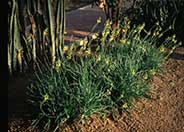
Common name:Yellow Stalked Bulbine
Botanical name:Bulbine frutescens
Bulbine frutescens is an evergreen perennial that grows 1.5' tall and wide. The leaves are narrow and long. This low-spreading plant is attractive year round.
Maintenance Tips
Bulbine frutescens is a grass-like succulent that has a very dense form that can grow 18" tall and wide. It can bloom throughout the year and is very attractive to hummingbirds, bees, and butterflies. To keep this plant low maintenance, plant it in full sun with excellent drainage. Rock gardens are a perfect location. The plant is drought tolerant once established but will require some supplemental soil as it is rooting. This plant can spread from underground roots, so it can be invasive if it is happy in the environment. There is very little maintenance required to keep it looking and performing its best, but it should be divided every couple of years to invigorate it. If the plant looks dull and discolored, there is a good chance it is going into its drought mode, so some supplemental water will kick start it again.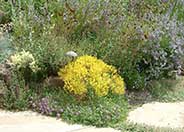
Common name:Ferned-Leaved Tickseed
Botanical name:Bidens ferulifolia 'Goldmarie'
Tickseed grows 14'-18" tall. It is a heat tolerant variety that is perfect for cascading, bright color in baskets, containers, and window boxes. Finely divided foliage is covered with gold, single flowers. It blooms until first frost. Plant in full sun. It needs well-drained soi.
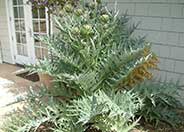
Common name:Artichoke
Botanical name:Cynara scolymus
This perennial will grow 4' tall and 6'-8' wide. It has silvery green leaves with bluish purple flowers that bloom in spring. Artichoke is a favorite fruit/vegetable of California kitchens but it is a great ornamental plant often overlooked for color contrast. It is very tolerant of little water when planted for ornamental purposes.
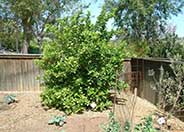
Common name:Improved Meyer Lemon
Botanical name:Citrus X 'Improved Meyer'
Improved Meyer Lemon is an evergreen tree that grows 3'-6' tall and 3'-6' wide; it has year around leaves that are glossy green. This tree likes well drained loam soil, with full sun; medium watering is required. It has white flowers and yellow edible fruit.
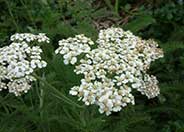
Common name:Yarrow
Botanical name:Achillea millefolium
This Achillea features spreading mats of fern-like rosettes, along with deeply divided leaves of a green or gray green color. In this form, the flowers are usually a white tone. Stems can reach 1'-2' above foliage, with flower clusters above foliage. Yarrows propagate easily from rooted cuttings or division, which should be performed in the early spring or fall. Following bloom, one should dead head the plant and divide the clumps when it appears crowded.
Maintenance Tips
Achillea millefolium is a flowering perennial that is often referred to as Yarrow. This native variety can develop a dense matt of foliage 1-2’ tall and 3’ wide with large clusters of flowers that stand another 12” above the foliage. This is an aggressive grower, so the best way to keep it low maintenance is to plant it in full sun, well-drained soil, and give it the space it needs to reach its mature size. Deadheading spent blooms is the key to a long blooming cycle. As the flowers fade, prune them back to the foliage, and new blooms will continue to emerge as long as the weather is warm. When the days are shorter and the wet weather arrives, they will often die back to the ground and go into a short period of dormancy. Pruning out the old foliage that looks mealy will help with airflow and will allow the plant to focus on growing its root system during the winter.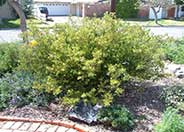
Common name:Louis Edmunds Manzanita
Botanical name:Arctostaphylos bakeri 'Louis Edmunds'
This is an upright shrub that grows 6'-8' tall. It is tall with green foliage and pink flowers during the winter and spring.
Designer: Susan Trindle
Photographer: GardenSoft
Practice grass-cycling by leaving short grass clippings on lawns after mowing, so that nutrients and organic matter are returned to the soil.
Remove irrigation water and fertilizer from areas where you don't want weeds to grow.